
Kinzua Bridge State Park is home to what was once the longest and tallest railway bridge in the entire world – The Kinzua Viaduct.

Kinzua Bridge State Park is located at 296 Viaduct Road, Mt Jewett, PA, in McKean County.

If you prefer to navigate using GPS coordinates, use 41.75892, -78.58647 to reach the Kinzua Bridge State Park parking lot.

The phone number for the Kinzua Bridge State Park office is 814-778-5467.

History of the Kinzua Viaduct
Originally owned and operated by the New York, Lake Erie, and Western Coal Company, the Kinzua Viaduct stood 301 feet tall and was 2,053 feet long when initially completed in 1882.

The iron bridge was constructed in just 94 days by the Phoenix Bridge Company, headquartered in Philadelphia.

In 1900 the Kinzua Viaduct was completely rebuilt out of steel, to accommodate larger, heavier locomotives pulling longer, heavier loads of oil, coal, and timber.

Freight trains regularly crossed the Kinzua Viaduct until 1959.

In 1963, the State of Pennsylvania acquired the viaduct and adjacent lands to create a state park.
Kinzua Bridge State Park opened in 1970, and in 1977, the Kinzua Viaduct was placed on the National Register of Historic Landmarks by the Federal Department of Interior.

No trains crossed the Kinzua Viaduct from 1959 until 1987, when passenger excursions were offered by the Knox and Kane Railroad.
These steam-powered trains continued to offer rides until 2002, when the excursions were paused so that repairs could be made to the aging bridge.

But before the restoration work was completed, a tornado touched down at the park on July 21, 2003 , destroying 11 of the 20 structural towers.

Deciding that the cost to rebuild the Kinzua Viaduct was too great, the State instead repurposed the remaining, still-standing 600 feet of bridge and built the Kinzua Skywalk, which opened in 2011.

Visiting Kinzua Bridge State Park Today
There are several trails to explore at Kinzua Bridge State Park, in addition to many historical exhibits inside the Visitors Center.

Throughout the park, you’ll find plenty of infographics telling the story of the Kinzua Viaduct and the timeline of events surrounding its fascinating history.

The Kinzua Skywalk
The most exciting trail at the park is certainly the 600 foot long journey to the end of the Kinzua Skywalk!

Standing 225 feet above the Kinzua Creek Gorge below, you have a panoramic view of the surrounding countryside.

Along your trip out the Skywalk, you’ll encounter several informational displays.

When you reach the end of the Kinzua Skywalk, you can stand on several glass panels and look 225 feet straight down to the gorge below.

There’s something exhilarating about knowing only 1 inch of glass separates you from eternity!
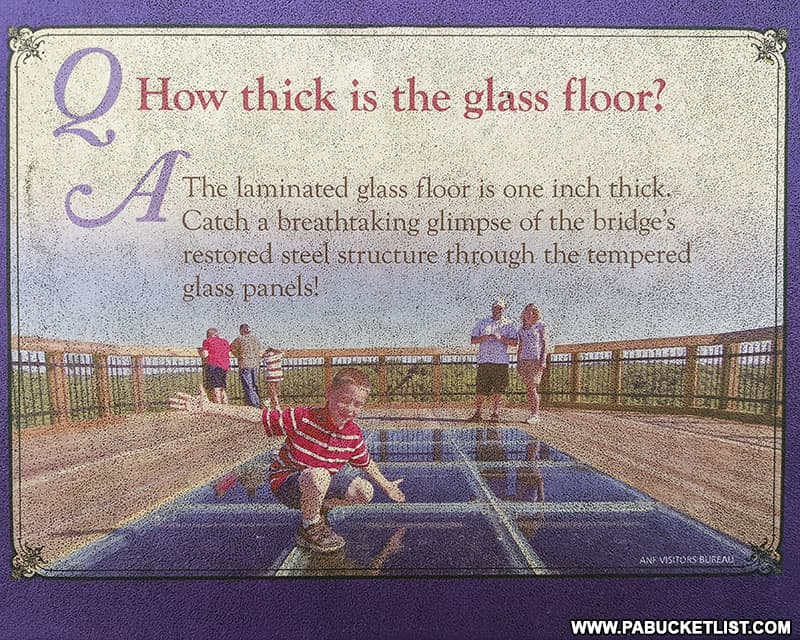
The view across the Kinzua Creek Gorge from the end of the Skywalk allows you to survey the tornado damage from 2003.

The view back towards the Visitor Center is remarkable as well.

The Kinzua Creek Trail
The Kinzua Creek Trail allows you to walk down a switchback trail from the Visitor Center to the gorge floor, then up the other side of the gorge to the northern end of the Kinzua Viaduct.

Along the way you’ll pass several observation areas that allow you to look straight across the gorge, through the center of the steel towers that support the Kinzua Skywalk.
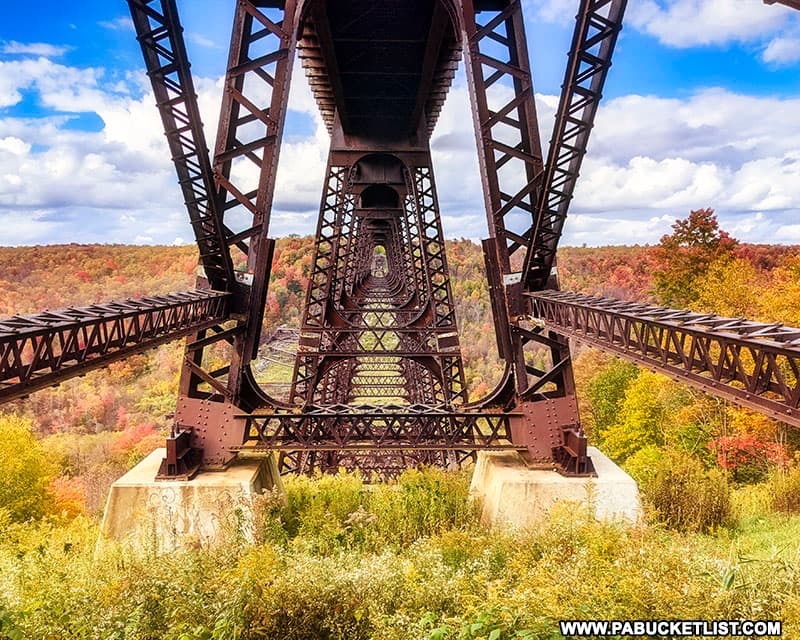
You can also look up through the glass floor of the Skywalk’s observation platform.

The Kinzua Creek Trail is rather steep, and while not technically challenging, it certainly requires some stamina to get to the bottom of the gorge and up the other side.

Your reward for making it to the bottom is an up-close look at the tornado-damaged towers that collapsed in 2003.

A footbridge over Kinzua Creek allows you a closer look at the opposite side of the former Kinzua Viaduct.

The mangled remains of the 120 year-old steel towers have held up extremely well to the elements, and may well be recognizable for another 120 years!

The views from the northern side of the Kinzua Creek Gorge are equally impressive.

Of course you can’t actually walk out onto the northern side of the Kinzua Viaduct, but even from behind the fence, the views are fantastic.

Here you can see first-hand the effects of the powerful tornado that hit in 2003, twisting the railroad tracks like spaghetti noodles.

Fall Foliage Views at Kinzua Bridge State Park
The fall foliage scenery at Kinzua Bridge State Park is exceptional!

From the top of the Skywalk to the bottom of the gorge, there are no bad views to be had here in October.

Winter Views at Kinzua Bridge State Park
Winter at Kinzua Bridge State Park is something special.

Unlike the hustle and bustle of summer and fall, winter days are quiet and still.

The debris field really stands out against a blanket of freshly fallen snow.

Just be sure to dress warm – McKean County is COLD in the winter!

Final Thoughts
The rise, fall, and rebirth of the Kinzua Viaduct is a fascinating part of Pennsylvania railroading history.

This is truly one of the most unique state parks in Pennsylvania.

The awesome power of Mother Nature is on full display at Kinzua Bridge State Park in McKean County!

Related Articles
The Salisbury Viaduct, built in 1912, is another Pennsylvania railroad bridge turned turned tourist attraction.

This 1,908 foot-long bridge is now part of the Great Allegheny Passage as it passes through Somerset County.

The Tunkhannock Viaduct is the largest concrete railroad bridge in the world, towering 240 feet above Tunkhannock Creek and the borough of Nicholson in Wyoming County, PA.

The Horseshoe Curve near Altoona is yet another piece of railroading history right here in Pennsylvania.

Unlike either the Kinzua Viaduct or the Salisbury Viaduct, the Horseshoe Curve is still very much in use by trains today, and is a must-see for railfans!

Nearby Attractions
The Marilla Bridges Trail is a scenic one-mile loop trail just outside Bradford in McKean County.

The trail features three wooden bridges and non-stop scenic views.

The Zippo/Case Museum is dedicated to telling the story of Zippo lighters and Case knives, two iconic products made in Bradford, Pennsylvania.

The 15,000-square-foot facility in McKean County includes the museum, a gift shop (naturally!) and the famous Zippo Repair Clinic.

Rimrock Overlook in Warren County offers visitors outstanding views of Kinzua Bay and the Allegheny National Forest which surrounds it.

Jakes Rocks Overlook is yet another scenic vista in the Warren County portion of the Allegheny National Forest, overlooking the Allegheny Reservoir.

Many people flock to this part of Pennsylvania hoping to catch a glimpse of the famed PA elk herd.

The 15 Best Elk Viewing Destinations in Pennsylvania will show you where to look, increasing your chances of seeing these amazing creatures up close.
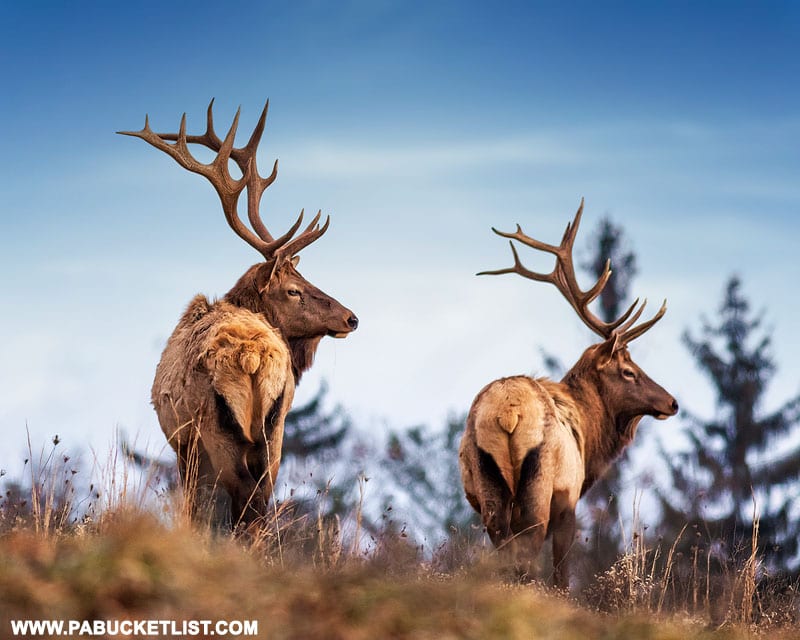
The Sherman Memorial Lighthouse in Forest County serves no navigational purpose, but at 75 feet tall, it’s the tallest functional lighthouse in Pennsylvania!
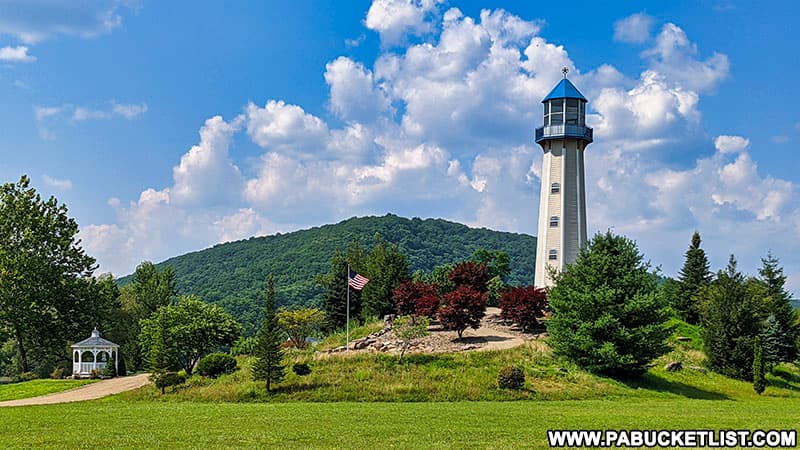
Beartown Rocks in Jefferson County features an exceptional scenic overlook perched high atop a “rock city” dating back to the last Ice Age!

The ruins of Austin Dam in Potter County are remnants of Pennsylvania’s second-deadliest flood.
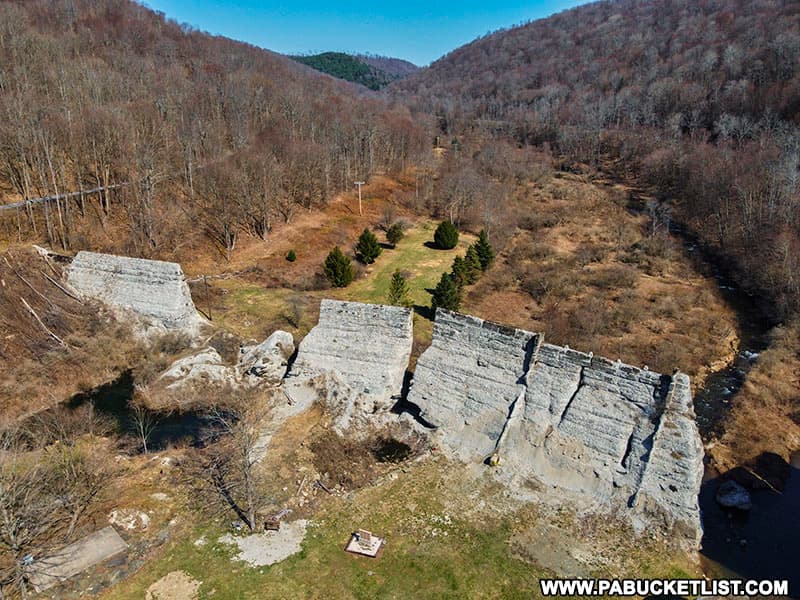
The abandoned Bayless Paper Mill is another fascinating historical site at the Austin Dam Memorial Park in Potter County.

8 Must-See Attractions in Elk County is your guide to the best things to see and do in McKean County’s neighbor to the south.
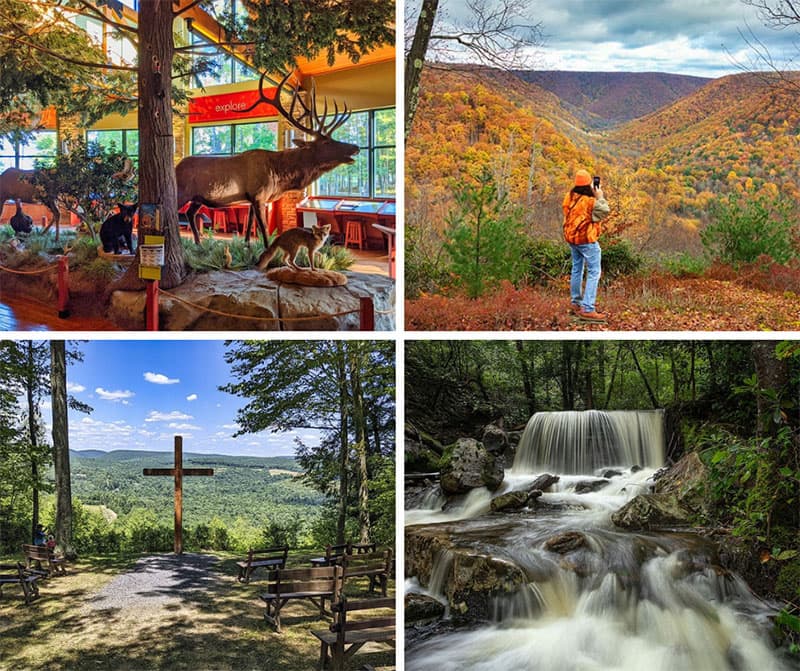
Did you enjoy this article?
If so, be sure to like and follow PA Bucket List on Facebook, Instagram, and/or Pinterest to learn more about the best things to see and do in Pennsylvania!
Click on any of the icons below to get connected to PA Bucket List on social media.


